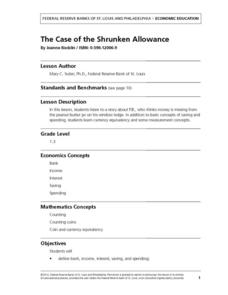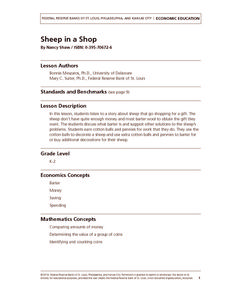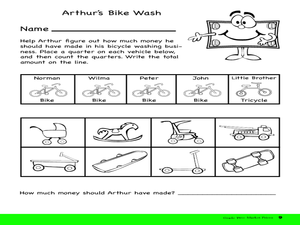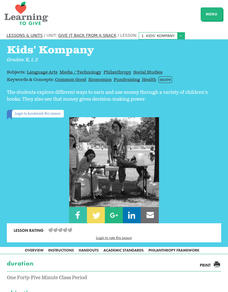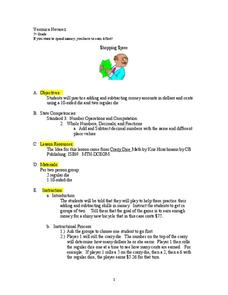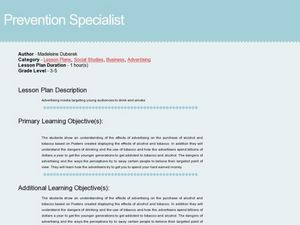Curated OER
Thinking About Money
Students evaluate various approaches to spending money.In this spending money literacy lesson, students broaden their financial goals by reading "Alexander Who Used to Be Rich Last Sunday" and "A Chair for My Mother."Students use a Venn...
Curated OER
Spending Money
Fourth graders become familiar with the ways people exchange goods and services. In this spending money lesson, 4th graders listen to a chapter from Henry and Beezus and record Henry's earnings and money spent. Students use correct...
Curated OER
The Bernstein Bear's Trouble with Money: Financial and Academic Literacy
What do figures of speech have to do with financial literacy? Take an interdisciplinary look at The Berenstain Bears' Trouble with Money to find out. Young analysts read about the cubs' spendthrift ways and how Mama and Papa Bear...
Federal Reserve Bank
The Case of the Shrunken Allowance
An allowance is an important thing! Make sure your kids know how to save and spend their own money. Using the book The Case of the Shrunken Allowance as a starting point, this plan covers income, spending and saving, counting, and more.
Federal Reserve Bank
Sheep in a Shop
What do you think sheep might be able to barter when they don't have quite enough to buy a gift? Your pupils can find out this and much more during this lesson about Sheep in a Shop, spending, saving, and bartering.
Curated OER
Money Vocabulary
In this money worksheet, learners look at 5 pictures and name each one, walk around the room find somebody that fits 6 scenarios and match 10 verbs in bold print with their appropriate phrases in grey.
Curated OER
Money Smart children
Students elementary financial vocabulary words: spend, save, invest and donate. In this finance lesson, students respond to the story "Sam and the Lucky Moon." Students describe the concepts of wants and needs, resources, scarcity,...
Curated OER
Money and Business (Art)
Third graders investigate world currency by creating their own coin art. In this government lesson, 3rd graders examine the characteristics of different coins and create their own design for a new one. Students discuss and...
Curated OER
Market Prices
Second graders understand that prices change. In this business, price and labor lesson, 2nd graders define the words market and price. Students read Arthur's Funny Money and answer questions related to earning and spending money....
Curated OER
Thinking About Money
Young scholars explore the concept of a personal budget. In this philanthropy lesson, students use a Venn diagram to compare 2 stories in which the main characters spend money in different ways.
Curated OER
Using Credit: Not for a Billion Gazillion Dollars
Fifth graders explore the concept of credit. In this consumer education lesson, the teacher uses the book Not for a Billion Gazillion Dollars to lead the class in a discussion about credit, debit, and income. Students then analyze their...
Curated OER
Vocabulary Lesson: Money Worksheet
In this money vocabulary worksheet, students answer 10 short answer questions about spending and saving money. Students must write about borrowing and lending money as part of this worksheet.
Curated OER
Give It Back From a Snack Lesson 1: Kids' Kompany
Students examine the ways to earn money and discover the different uses for money. They read children's literature and draw pictures of uses for money that benefit the common good.
Curated OER
Shopping Spree
Sixth graders examine currency by completing monetary equations. In this economics lesson, 6th graders participate in a numbers experiment where they roll a die and earn money based on their roll. Students compete for their...
Curated OER
Advertising Media: Youth Drinking and Smoking
Scholars examine the effect of media and advertising on youth drinking and smoking. They determine what advertising means, how much money is spent on it, and how different age groups are targeted. They watch a movie and examine pictures...
Curated OER
English Idioms II - Money Talk
In this idioms activity, students match the idioms to their meaning. Students match 12 idioms to their correct meaning on this activity.
Curated OER
Next Year's Seeds
Reading, a math game, and a simulation activity provide the engagement on a lesson about seeds and crops. Learners in grades two through four read an informational passage about crops, seeds, and farming. They highlight important...
Curated OER
Do You Really Need It?
Fourth graders read and share chapters of The Boxcar Children. In this wants and needs instructional activity, 4th graders understand through their reading the differences between wants and needs. Students complete a worksheet about...
Curated OER
Decision-Making Tool
Students work together to decide where their donated money should go. They list the possible choices and evaluate what is most important to them. They must have a consensus before the money is donated.
Curated OER
Kinder Bakeshop
Students create a bakery where they sell cookies for a week. Students identify and interpret how to make their own money and deposit it into their bank accounts. Students also identify how to withdraw money from these accounts in order...
Virginia Department of Education
Grade 8 Writing Prompts
Imagine four pages of writing prompts. Although designed specifically for eighth graders, the topics could be used for upper-elementary and high school writers as well.
24x7 Digital
TeachMe: 1st Grade
Let your eager learners practice their basic arithmetic and spelling skills with this fun interactive resource! For any primary grade teacher with access to an Apple mobile device, this is a must-have application.
K12 Reader
What is a Tribal Government?
What is life like on a Native American reservation? Learn about the ways a tribal government works with a reading comprehension activity. After reading a short passage, kids use context clues to answer five comprehension questions.
K12 Reader
What is a Tribal Government?
How are tribal governments similar to local or state governments? After reading a short article on tribal governments, individuals draw evidence from the provided article to respond to this reading comprehension question.



